Chapter 8
Asking for Directions
In This Chapter
 Asking questions with “where” and “how”
Asking questions with “where” and “how”
 Understanding the directions you’re given
Understanding the directions you’re given
For anyone in an unfamiliar place, asking for directions (and understanding them) is an indispensable skill. In this chapter, we give you the words and phrases you need in order to get to your destination without getting lost in the process. As exciting as exploring a new place may seem, being lost in a strange city can be scary. We give you the info you need to get wherever you want to go.
Using “Where” and “How” Questions
In Russia, most passers-by — who at first may seem to be preoccupied with their own business — are actually very happy to help you if you don’t know where a place is or how to get there. As a matter of fact, you may even be doing them a favor by distracting their attention from their routine duties. When in doubt, just ask! In the following sections you discover how to ask for directions with two simple words: “where” and “how.”
Asking where a place is
 If “where” indicates location rather than direction of movement and you aren’t using the so-called verbs of motion (to go, to walk, to drive, and so on), use the word где.
If “where” indicates location rather than direction of movement and you aren’t using the so-called verbs of motion (to go, to walk, to drive, and so on), use the word где.
 If “where” indicates direction of movement rather than location or is used in a sentence with verbs of motion (to go, to walk, to drive, and so on), use the word куда.
If “where” indicates direction of movement rather than location or is used in a sentence with verbs of motion (to go, to walk, to drive, and so on), use the word куда.
Here are a couple examples:
Где Саша работает? (gdyeh sah-shuh ruh-boh-tuh-yeht?) (Where does Sasha work?)
Куда Саша идёт? (kooh-dah sah-shuh ee-dyoht?) (Where is Sasha going?)
Imagine you’re looking for the nearest bus stop to get to a museum that’s first on the list of places you want to see in a certain city. There you are, helplessly standing on the corner of a crowded street, looking for the person with the friendliest expression to approach with your question. You spot a young woman who seems nice. Why not ask her?
Hold on! What exactly do you intend to ask her? If you’re planning to ask “Where is the bus stop?” first think about how you’re going to translate the word “where.” Are you inquiring about location or destination here? Obviously, your question is about location — the location of the bus stop. Go back to the rule we just provided you. In a sentence or question asking about location, you use где. Now you can go ahead and ask your question:
Где остановка автобуса? (gdyeh ahs-tuh-nohf-kuh uhf-toh-booh-suh?) (Where is the bus stop?)
Now, imagine a slightly different situation. You’re at the bus station. A bus has just arrived and you want to know where it’s going. The best person to ask is probably the driver himself: He should know where the bus is headed, even if today is his first day on the job. Before you ask your question, think first about how to begin it: with где or куда? Is your question “Where is the bus going?” about location or destination? Yes, you’re asking a question about the destination! Go back to the earlier rules: If the main point of your question is destination, you should use the word куда. Here’s your question:
Куда идёт этот автобус? (kooh-dah ee-dyoht eh-taht uhf-toh-boohs?) (Where is this bus going?)
Inquiring how to get to a place
Как я отсюда могу попасть в музей? (kahk ya aht-syooh-duh mah-gooh pah-pahst’ v mooh-zyehy?) (How do I get to the museum from here?)
 в университет (v ooh-nee-veer-see-tyeht) (to the university)
в университет (v ooh-nee-veer-see-tyeht) (to the university)
 в школу (v shkoh-looh) (to school)
в школу (v shkoh-looh) (to school)
 в магазин (v muh-guh-zeen) (to the store)
в магазин (v muh-guh-zeen) (to the store)
 на стадион (nuh stuh-dee-ohn) (to the stadium)
на стадион (nuh stuh-dee-ohn) (to the stadium)
 на вокзал (nuh vahk-zahl) (to the railway station)
на вокзал (nuh vahk-zahl) (to the railway station)
 на фабрику (nuh fah-bree-kooh) (to the factory)
на фабрику (nuh fah-bree-kooh) (to the factory)
 на завод (nuh zuh-voht) (to the industrial plant)
на завод (nuh zuh-voht) (to the industrial plant)
 на площадь (nuh ploh-sh’eet’) (to the square)
на площадь (nuh ploh-sh’eet’) (to the square)
The Next Step: Understanding Specific Directions
When you’re asking for directions, it’s important to understand what you’re being told. In the following sections, you find out how to understand verbs in the imperative mood as well as prepositions and other phrases that often are used in giving and receiving directions.
Making sense of commands in the imperative mood
Usually, when somebody gives you directions, they tell you where to go, not just where something is located. The imperative mood is the form of the verb in which you hear and give directions. It’s indispensable for making polite requests, giving commands, and generally ordering people around.
 Идите прямо (ee-dee-tee prya-mah) (Go straight)
Идите прямо (ee-dee-tee prya-mah) (Go straight)
 Идите обратно (ee-dee-tee ahb-raht-nah) (Go back)
Идите обратно (ee-dee-tee ahb-raht-nah) (Go back)
 Идите прямо до (ee-dee-tee prya-muh duh) (Go as far as) + the noun in the genitive case
Идите прямо до (ee-dee-tee prya-muh duh) (Go as far as) + the noun in the genitive case
 Подойдите к (pah-dahy-dee-tee k) (Go up to) + the noun in the dative case
Подойдите к (pah-dahy-dee-tee k) (Go up to) + the noun in the dative case
 Идите по (ee-dee-tee puh) (Go down along) + the noun in the dative case
Идите по (ee-dee-tee puh) (Go down along) + the noun in the dative case
 Пройдите мимо (prahy-dee-tee mee-mah) (Pass by) + the noun in the genitive case
Пройдите мимо (prahy-dee-tee mee-mah) (Pass by) + the noun in the genitive case
 Поверните налево (puh-veer-nee-tee nuh-lyeh-vah) (Turn left or Take a left turn)
Поверните налево (puh-veer-nee-tee nuh-lyeh-vah) (Turn left or Take a left turn)
 Поверните направо (pah-veer-nee-tee nuh-prah-vah) (Turn right or Take a right turn)
Поверните направо (pah-veer-nee-tee nuh-prah-vah) (Turn right or Take a right turn)
 Заверните за угол (zuh-veer-nee-tee zah ooh-gahl) (Turn around the corner)
Заверните за угол (zuh-veer-nee-tee zah ooh-gahl) (Turn around the corner)
 Перейдите улицу (pee-reey-dee-tee ooh-lee-tsooh) (Cross the street)
Перейдите улицу (pee-reey-dee-tee ooh-lee-tsooh) (Cross the street)
Listening for prepositions
 около (oh-kah-lah) (near) + a noun in the genitive case
около (oh-kah-lah) (near) + a noun in the genitive case
 рядом с (rya-dahm s) (next to) + a noun in the instrumental case
рядом с (rya-dahm s) (next to) + a noun in the instrumental case
 напротив (nuh-proh-teef) (opposite, across from) + a noun in the genitive case
напротив (nuh-proh-teef) (opposite, across from) + a noun in the genitive case
 за (zah) (beyond) + a noun in the instrumental case
за (zah) (beyond) + a noun in the instrumental case
 позади (puh-zuh-dee) (behind) + a noun in the genitive case
позади (puh-zuh-dee) (behind) + a noun in the genitive case
 перед (pyeh-reet) (in front of) + a noun in the instrumental case
перед (pyeh-reet) (in front of) + a noun in the instrumental case
 между (myehzh-dooh) (between) + a noun in the instrumental case
между (myehzh-dooh) (between) + a noun in the instrumental case
 внутри (vnooh-tree) (inside) + a noun in the genitive case
внутри (vnooh-tree) (inside) + a noun in the genitive case
 снаружи (snuh-rooh-zhih) (outside) + a noun in the genitive case
снаружи (snuh-rooh-zhih) (outside) + a noun in the genitive case
 над (naht) (above) + a noun in the instrumental case
над (naht) (above) + a noun in the instrumental case
 под (poht) (below) + a noun in the instrumental case
под (poht) (below) + a noun in the instrumental case
When you ask a simple question like Где музей? (gdyeh mooh-zyehy?) (Where is the museum?), you may get a response like this:
Музей рядом с театром, за магазином, между аптекой и почтой, напротив универмага. (mooh-zyehy rya-dahm s tee-aht-rahm, zuh muh-guh-zee-nahm, myehzh-dooh uhp-tyeh-kahy ee pohch-tahy, nuh-proh-teef ooh-nee-veer-mah-guh.) (The museum is next to the theater, beyond the store, between the pharmacy and the post office, opposite the department store.)
Keeping “right” and “left” straight
 справа от (sprah-vuh aht) (to the right of) + a noun in the genitive case
справа от (sprah-vuh aht) (to the right of) + a noun in the genitive case
 направо (nuh-prah-vah) (to the right)
направо (nuh-prah-vah) (to the right)
 слева от (slyeh-vuh aht) (to the left of) + a noun in the genitive case
слева от (slyeh-vuh aht) (to the left of) + a noun in the genitive case
 налево (nuh-lyeh-vuh) (to the left)
налево (nuh-lyeh-vuh) (to the left)
 на левой стороне (nuh lyeh-vahy stah-rah-nyeh) (on the left side)
на левой стороне (nuh lyeh-vahy stah-rah-nyeh) (on the left side)
 на правой стороне (nuh prah-vahy stah-rah-nyeh) (on the right side)
на правой стороне (nuh prah-vahy stah-rah-nyeh) (on the right side)

Here’s a short exchange that may take place between you and a friendly-looking Russian woman:
You: Извините, где магазин? (eez-vee-nee-tee, gdyeh muh-guh-zeen?) (Excuse me, where is the store?)
The woman: Mагазин справа от аптеки. (muh-guh-zeen sprah-vuh aht uhp-tyeh-kee.) (The store is to the right of the pharmacy.)
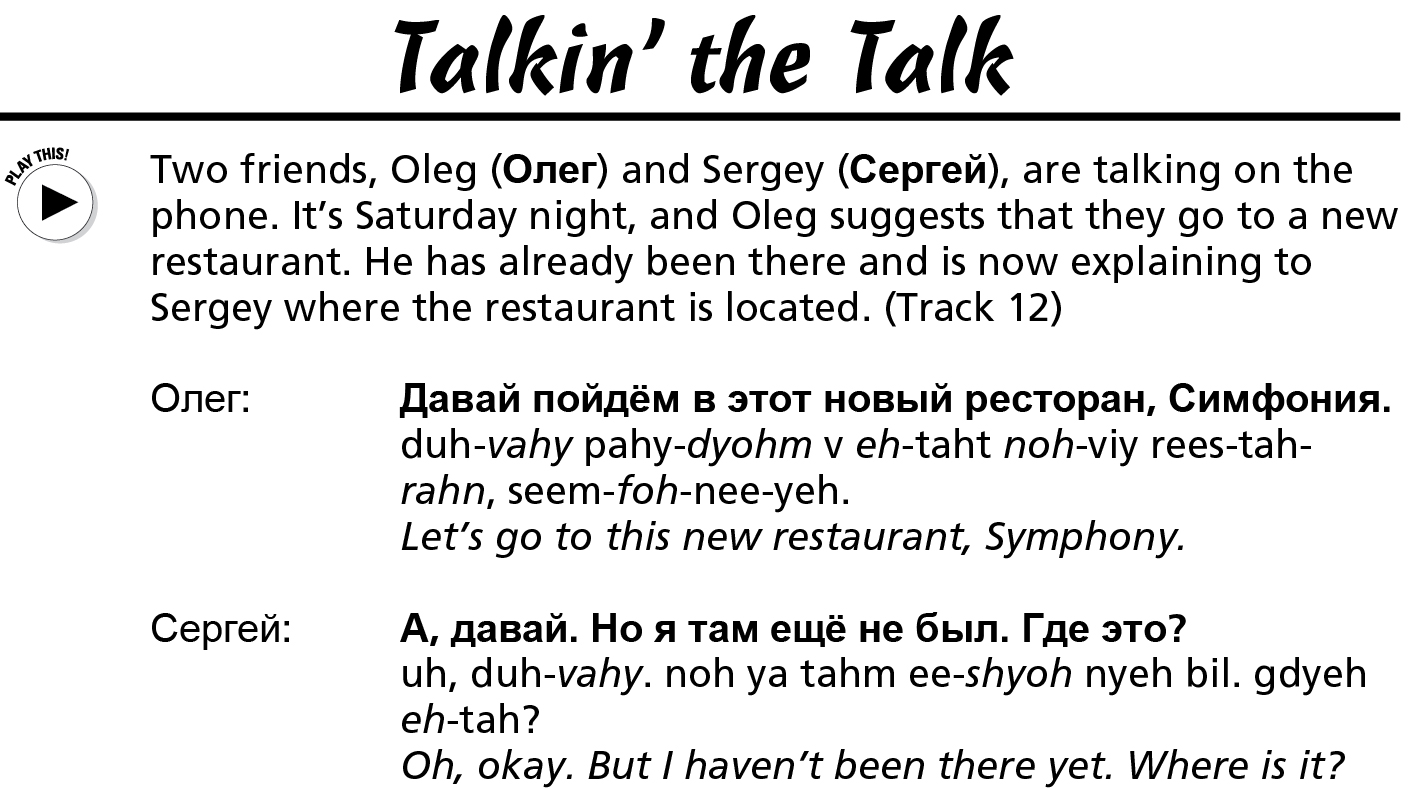
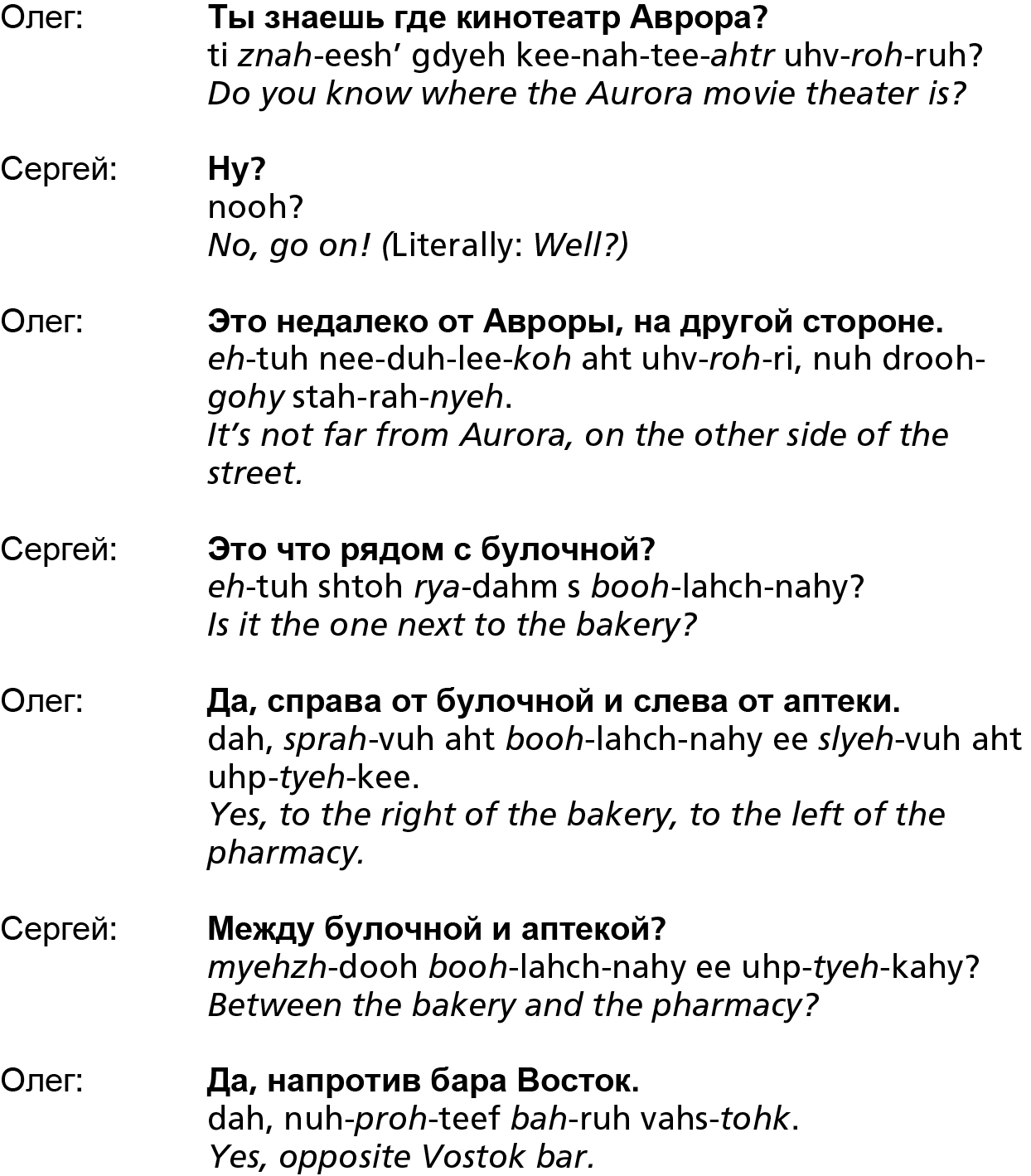
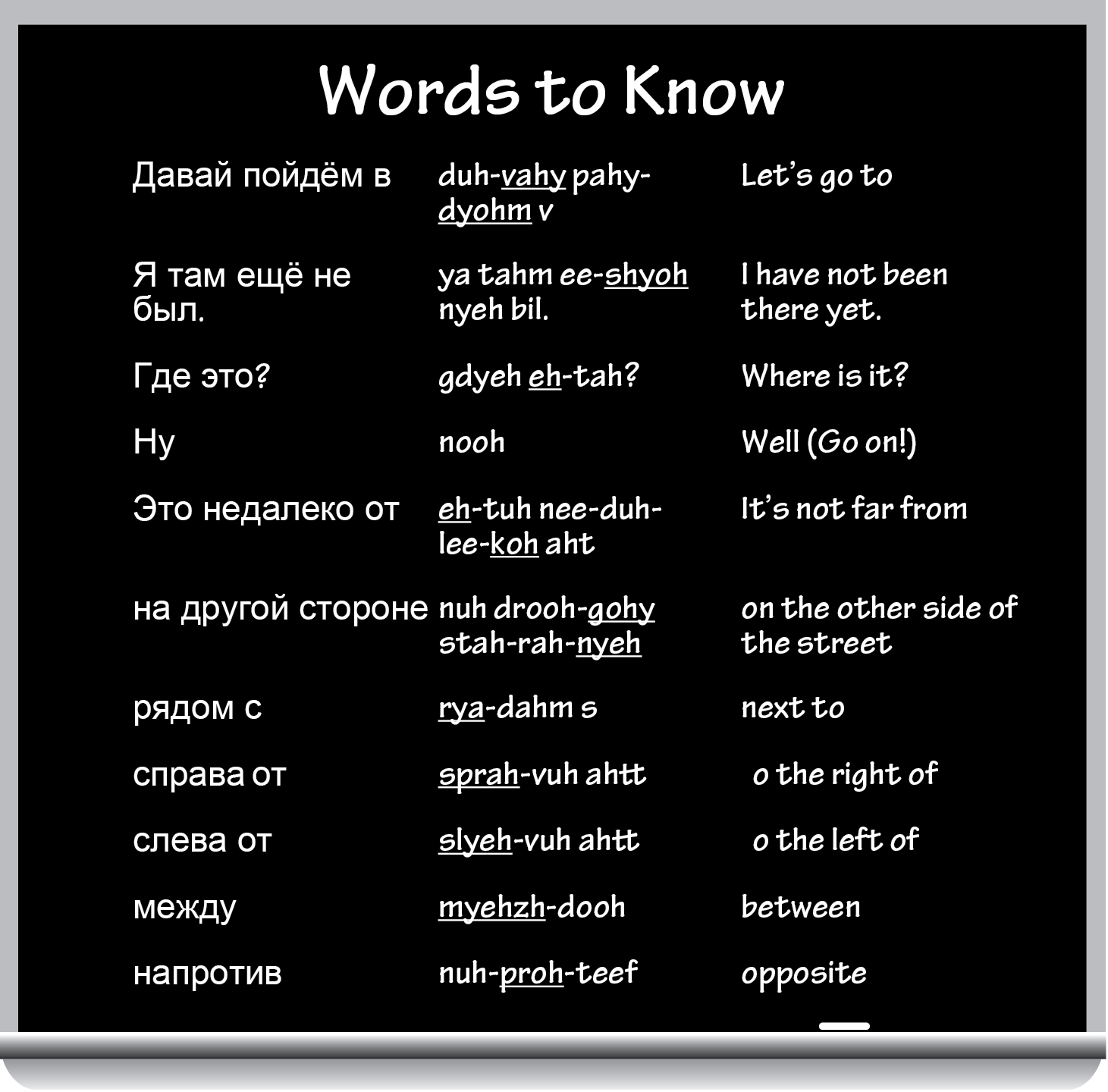
Going here and there
The English word here has two different Russian equivalents:
 Use Здесь (zdyehs’) to indicate location — in other words, when you’re not dealing with a verb of motion.
Use Здесь (zdyehs’) to indicate location — in other words, when you’re not dealing with a verb of motion.
 Use сюда (syooh-dah) if here indicates destination and is used with a verb of motion, such as go, come, drive, and so forth.
Use сюда (syooh-dah) if here indicates destination and is used with a verb of motion, such as go, come, drive, and so forth.
Likewise, the word there has two Russian equivalents:
 Use там (tahm) to indicate location.
Use там (tahm) to indicate location.
 Use туда (too-dah) to indicate destination.
Use туда (too-dah) to indicate destination.
Compare these examples:
Остановка автобуса здесь. (ahs-tah-nohf-kuh uhf-toh-booh-suh zdyehs’.) (The bus stop is here.)
Иди сюда! (ee-dee syooh-dah!) (Come here!)
Магазин там. (muh-guh-zeen tahm.) (The store is there.)
Иди туда! (ee-dee tooh-dah!) (Go there!)

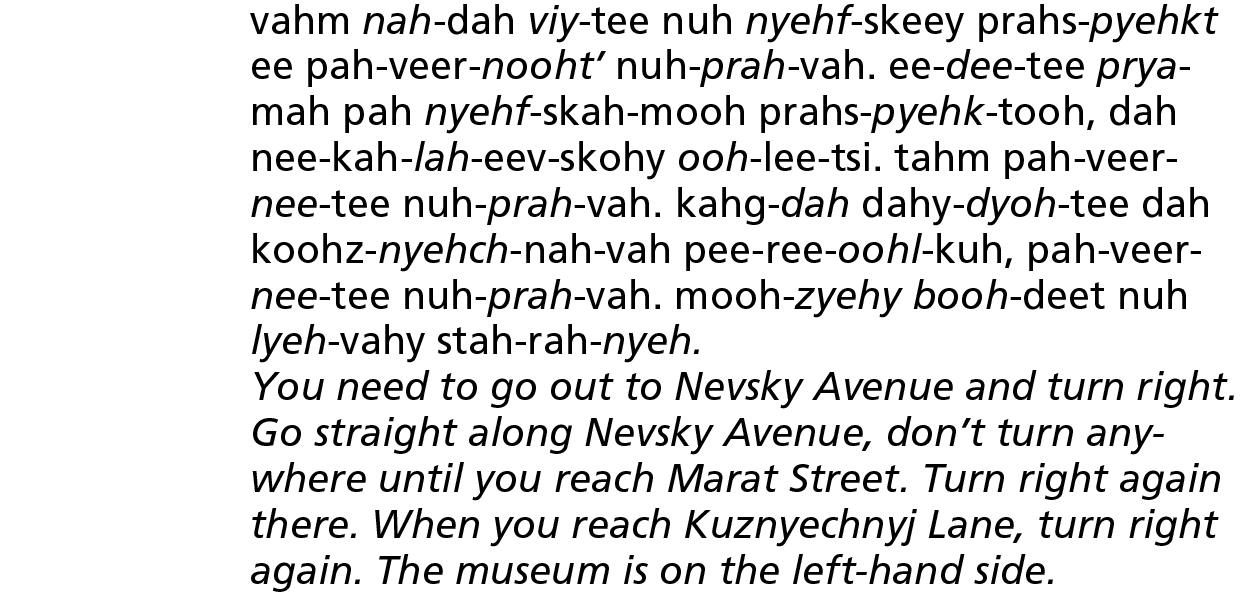
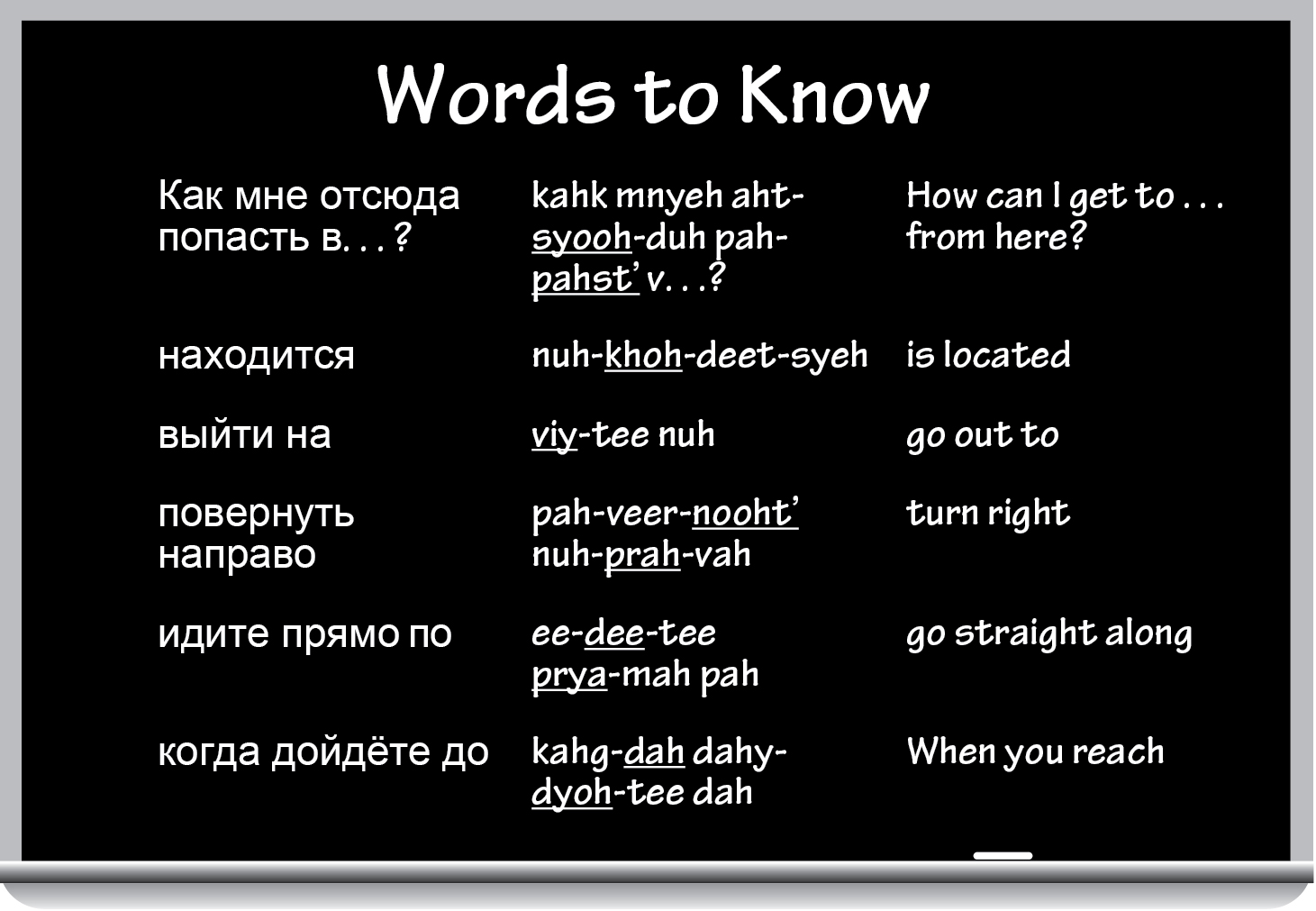
Traveling near and far
Sometimes you don’t want detailed information about directions. You just want to know whether someplace is near or far and how long it takes to get there. The Russian word for near is близко (blees-kah), and the Russian word for far is далеко (duh-lee-koh).
In giving directions, Russians usually like to indicate distance in terms of the time it takes to get there. Outdoorsy, younger people may say, for example:
Это близко. Минут пятнадцать пешком. (eh-tah blees-kah. mee-nooht peet-naht-suht peesh-kohm.) (It’s near. About 15 minutes’ walk.)
Those people who don’t fancy walking that much may see the same distance differently and say:
Это далеко. Минут пятнадцать пешком. (eh-tah duh-lee-koh. mee-nooht peet-naht-suht’ peesh-kohm.) (It’s far. About 15 minutes’ walk.)
Это довольно далеко. Две остановки на трамвае/автобусе/троллейбусе/метро. (eh-tah dah-vohl’-nah duh-lee-koh. dvyeh ahs-tuh-nohf-kee nuh truhm-vah-ee/uhf-toh-booh-see/trah-lyehy-booh-see/meet-roh.) (That’s quite far away. Two stops by the tram/bus/trolleybus/metro.)



 A very popular way of indicating the distance in Russia is to count the number of bus, tram, trolleybus, or subway stops to the place you’re inquiring about. If you think a 15-minute walk is a big deal, especially if you’re tired, you may say in response:
A very popular way of indicating the distance in Russia is to count the number of bus, tram, trolleybus, or subway stops to the place you’re inquiring about. If you think a 15-minute walk is a big deal, especially if you’re tired, you may say in response: